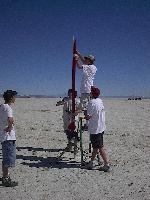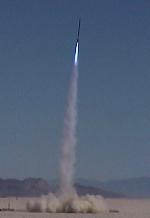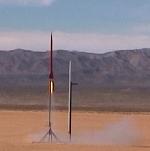AIR

| Diameter: | 3.1" | Type: | High Performance |
| Length: | 85" | Status: | Repairs - 4 flights |
| Motor Mount: | 76mm | Build Dates: | 2003-04-01 to 2003-09-12 |
AIR was my first attempt at building a high performance rocket. Built from FWFG with G10 fins, the original version suffered from serious dynamic stability problems and tore itself apart spectacularly. The rebuild didn't fare much better. With a new booster section, it now flies straight, fast, and high.
Flights
A few days before the launch, I realized that I had a minimum diameter 3" rocket and a 4 grain 76mm motor. Why not put them together? Prep went quickly, and I was one of the first to the pads in the morning. I had mixed up a large batch of thermite for Jeff and Wedge's Ajax Booster, and took a few grams to light my L motor with. When Robin Meredith got to zero, there was a long pause as he tried each pad in sequence, until finally he found the right one, and the rocket took off like a bat out of hell. It wiggled slightly as it passed through Mach, but kept going into the thin haze. After burnout, it disappeared, and so we began searching downrange where other projects had been landing. Within a few minutes, we had located the vehicle intact, beeping out 17,230. SWEET.
Well, it was bright and early on the first morning of Turkey Shoot. I had installed the motor into AIR already back at the hotel, and I was nearly ready to fly. All that was left was to install ejection charges, hook up the altimeters, pack the chutes, and push the button. Problem was, there was no range set up yet! I had the vehicle all prepped, and then helped Tripoli Vegas to get everything ready for the launch. After BSing with Andy Woerner for a while (hoping to Providence that I wouldn't be the first person to fly that morning), I finally trekked out to the pads around 11:00. After arming the altimeters and installing a Thermalite igniter, I gave Kendall Reed the go-ahead to let her rip. The motor took a little time to come up to pressure, but eventually a yellow laser of flame emerged from the base of the motor and we were on our way. There was light cloud cover so the small rocket became difficult to see for the second half of the burn, and disappeared totally after burnout at 6.5 seconds. A pop filtered down from above, indicating that something had fired and the rocket was hopefully descending drogueless. Eventually I caught sight of it again with the help of Gordon McDaniel, and saw it deploy its main parachute at 800 feet. We recovered it quickly from the bushes and deprepped it. 10,700 feet on a full K motor... I wonder what it will do on an M?
The old booster section could be salvaged by trimming off 24" of tube and adding a new payload section. The shorter rocket looked plenty stable in RockSim, and so I put it on the pad with high hopes, loaded with a CTI J285. As soon as it left the rail, however, it performed a horrible oscillation maneuver -- something was definitely not right -- and at apogee, nothing happened. The CTI motor never fired its ejection charge for some reason, and the rocket piled in to the lakebed. Good riddance, I figured. This rocket deserved bigger and better fins.
My school rocket club had been building this rocket for several months. However, the big flight didn't go exactly as planned. Les' motor worked great, ripping the rocket dead straight off the rail. However, as speed built, the rocket began to cone, and soon the payload section decided that it didn't like going through Mach at an angle of attack of 10 degrees. As such, it decided to bail on the rest of the rocket, which went happily flying off sideways, impaling itself into the playa at a nice angle. The upper section was recovered intact, and lives to fly again. Special thanks to Jeff at Loki Research for letting us borrow an ARTS flight computer to fly in the nose, Jim Amos at MissileWorks for giving us the RRC2 for a good price, and Les at NASSA for the AWESOME motor.

others: arts arming | paul, me, M2400
video




